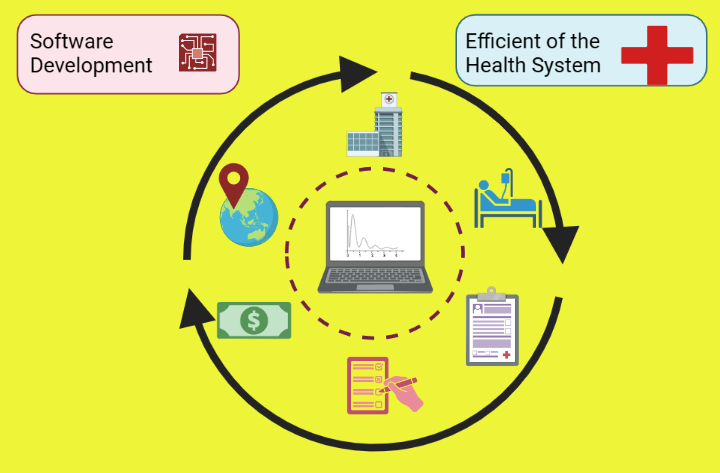Possible directions of increasing the efficiency of the health system through software development
DOI:
https://doi.org/10.14295/bjs.v3i1.450Keywords:
medical software, health information system, health sector, information communication technologies, computersAbstract
In the modern world, software is practically inevitable and present everywhere. Today, software represents the key to the success of most computer systems and at the same time the differentiation factor of the organizations that own it. Software has become an essential component in healthcare decision-making and the basis of scientific research and healthcare problem solving. The development of microprocessors enabled the widespread infiltration of computers into biomedical instruments for measuring, monitoring and displaying a number of parameters in physiology, clinic, radiology, nuclear medicine, laboratories and others. Digital communication techniques have enabled the networking of computers and the exchange of large amounts of information needed by expert systems to improve the quality of decision-making.
References
AAMI, (2012). AAMI TIR45:2012 (R2018). Guidelines on the use of agile practices in medical device software development.
Bates, D. V., & Gawande, A A. (2003). Improving security with information technology. New England Journal of Medicine, 348(25), 2526-2534. DOI: https://doi.org/10.1056/NEJMsa020847
Blois, M. (1984). Information and medicine: The nature of medical descriptions. University of California Press, Berkeley and Los Angeles, 298 p. http://resource.nlm.nih.gov/8400408
Bloom, B., & Duncan, K. (1990). History of medical informatics. ACM Press, New York, Eds. DOI: https://doi.org/10.1145/89482
Debois, P. (2011). DevOps: a software revolution in the making. Journal of Information Technology Management, 24(8), 3-39. Available in: https://www.cutter.com/article/devops-software-revolution-making-416511. Access at 07/16/2023.
Devedžić, V., & Božović, Z. (1992). Expert systems and their application in medicine. CMS of the University of Belgrade, Belgrade.
Deželić, G. J. (1987). Health informatics. Faculty of Medicine, University of Zagreb, Zagreb.
Dora, S. K., & Dubei, P. (2013). Software development life cycle (SDLC) analytical comparison and research on traditional and agile methodology. National Monthly Refereed Journal of Research in Science & Technology, 2(8), 22-30.
Dotlić, R., Maksimović, R., Dragićević, T., & Gajić, M. (1995). Education in medical informatics at the faculty of medicine in Belgrade. Journal of Serbian Medical Society, 2, 1-4.
Dragićević, D., Milosavljević, A., & Atanasijević, S. (2013). Combination of traditional and agile project management methodologies on the health information system software project in the Ministry of Defense of the Republic of Serbia. In: 16th International Conference on Quality Management. Belgrade: ICDKM.
Hu, S., Huang, M., Feng, V., & Zhang, I. (2017). A smart model of health care services for the elderly on ECA-S rules. In: Software Engineering Research, Management and Applications (SERA), 15th IEEE International Conference on, 93-97 p. http://dx.doi.org/10.1109/SERA.2017.7965712 DOI: https://doi.org/10.1109/SERA.2017.7965712
ISO. (2003). 13485:2003, Medical devices - Quality management systems - Requirements for regulatory purposes.
Kušniruk, A. V., & Patel, V. L. (2004). Cognitive and application engineering methods for evaluating clinical information systems. Journal of Biomedical Informatics, 37(1), 56-76. https://doi.org/10.1016/j.jbi.2004.01.003 DOI: https://doi.org/10.1016/j.jbi.2004.01.003
Kneuper, R. (2018). Software processes and life cycle models. Cham: Springer, Edition Number, 1, 345 p. https://link.springer.com/book/10.1007/978-3-319-98845-0 DOI: https://doi.org/10.1007/978-3-319-98845-0
Marinković, J., Babić, D., Maksimović, R., Stanisavljević, D. (1995). Elements of computer support in scientific research in the field of medicine. Serbian Archives of Medicine, 2, 14-17.
McNurlin, B., & Sprague, R. (2004). Managing Information Systems in Practice", Pearson Prentice Hall. Available in: https://dokumen.pub/information-systems-management-in-practice-1292023546-9781292023540.html#Ralph%3BBui. Access in 07/16/2023.
Software as a Medical Device. (2014). A possible framework for risk categorization and response considerations IMDRF/SaMD VG/N12, (September 2014).
Ruparelia, N. B. (2010). Software development life cycle models. ACM SIGSOFT Software Engineering Notes, 35(3), 8-13. https://doi.org/10.1145/1764810.1764814 DOI: https://doi.org/10.1145/1764810.1764814
Simić, S., Marinković, J., Stanojević, S., Radovanović, M., Anđelski, H., Atanasković, Z., Grujović, G., Pavlović, Ž., Đukić, L. J., & Obradović, M. (1995). Analysis of the state of information technology in Serbian health institutions. Journal of the Serbian Medical Society, 2, 5-8. Available in: https://pubmed.ncbi.nlm.nih.gov/18193775/. Access in 07/16/2023.
Weiguo, L., & Xiaomin, F. (2009). Software development practices for FDA compliant medical devices In: International Joint Conference on Computational Science and Optimization, Sanya, Hainan, China, 24-26 April, 388-390 p. http://doi.org/10.1109/CSO.2009.191 DOI: https://doi.org/10.1109/CSO.2009.191

Downloads
Published
How to Cite
Issue
Section
License
Copyright (c) 2024 Laxmi Rathour, Dragan Obradovic, Lakshmi Narayan Mishra, Vishnu Narayan Mishra

This work is licensed under a Creative Commons Attribution 4.0 International License.
Authors who publish with this journal agree to the following terms:
1) Authors retain copyright and grant the journal right of first publication with the work simultaneously licensed under a Creative Commons Attribution License that allows others to share the work with an acknowledgement of the work's authorship and initial publication in this journal.
2) Authors are able to enter into separate, additional contractual arrangements for the non-exclusive distribution of the journal's published version of the work (e.g., post it to an institutional repository or publish it in a book), with an acknowledgement of its initial publication in this journal.
3) Authors are permitted and encouraged to post their work online (e.g., in institutional repositories or on their website) prior to and during the submission process, as it can lead to productive exchanges, as well as earlier and greater citation of published work.




